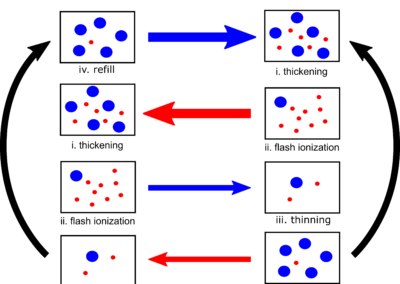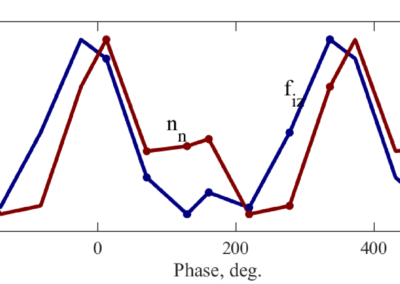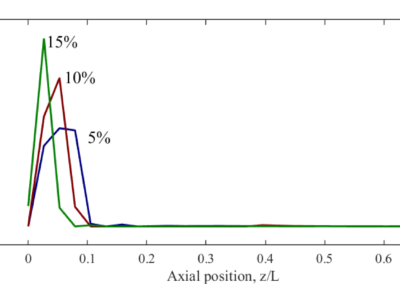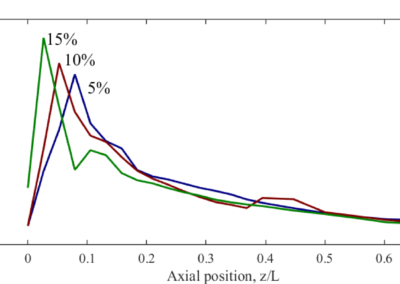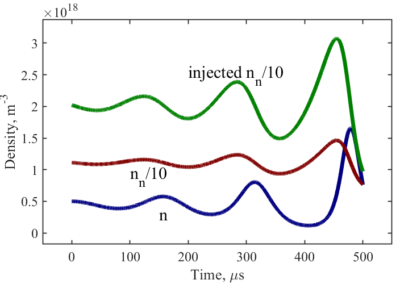Project
Stability Analysis of Hall Thrusters
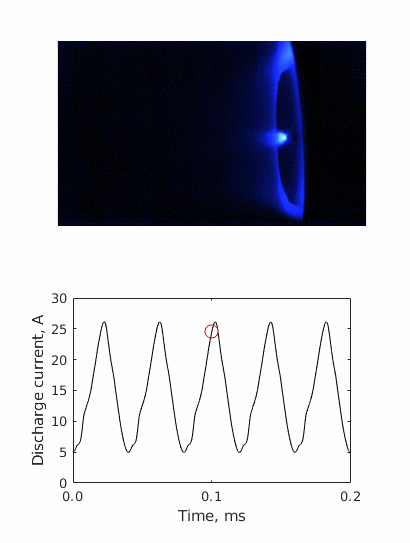
The H9 Hall thruster operating on krypton at 400 V and 15 A. At this condition, the breathing mode is particularly coherent at 20 kHz.
Despite active study for decades, the stability of Hall thrusters is still not completely understood from first principles. Specifically, these devices exhibit several instabilities that are not completely characterized theoretically. These stability issues are problematic in two ways: the presence of instabilities may influence performance in-flight, and the lack of understanding of these phenomena makes it difficult to reproduce them with numerical simulation.
Hall thruster stability is studied in several ways. First, it can be examined experimentally in terms of empirical trends in oscillation characteristics with operating parameters. For example, the evolution of oscillation frequency with discharge voltage can be mapped experimentally to understand the stability of a thruster as a function of voltage. Second, it can be examined experimentally in terms of high-level performance metrics. For example, the evolution of power-normalized thrust with oscillation amplitude can be determined to illuminate the effect of instabilities on performance. Finally, it can be examined theoretically and numerically to understand the mechanism governing an instability. For example, a theoretical model can be developed and compared to low-level experimental data to assess the stability criteria for a certain oscillatory mode.
At PEPL, we have approached Hall thruster stability in all three ways. The work of McDonald et al. performed initial characterization of the Hall thruster breathing mode and spoke mode using high-speed imaging. Aside from identifying important trends in frequency and amplitude of these modes, McDonald found evidence that azimuthal spokes might play a role in electron transport in Hall thrusters. Sekerak et al. evaluated the changes in thruster performance with low-frequency oscillation strength and found that the breathing mode typically corresponds to low thrust-to-power. Finally, Dale et al. explored the breathing mode theoretically and numerically, finding that existing theories for it are insufficient. Dale performed additional experimental characterization of this mode and found evidence for the involvement of an upstream ionization process.
Selected Publications
Mode Transitions in Hall-Effect Thrusters Induced by Variable Magnetic Field Strength
M.J. Sekerak, A.D. Gallimore, D.L. Brown, R.R. Hofer, and J.E. Polk
Plasma Oscillations and Operational Modes in Hall Effect Thrusters
Sekerak, M.
Perturbation analysis of ionization oscillations in Hall effect thrusters
K. Hara, M.J. Sekerak, I.D. Boyd, and A.D. Gallimore
Mode transition of a Hall thruster discharge plasma
K. Hara, M.J. Sekerak, I.D. Boyd, and A.D. Gallimore
Experimental Evidence for Ion Acoustic Solitons in the Plume of a Hollow Cathode
Georgin, M.P., Jorns, B.A., and Gallimore, A.D.
Non-Invasive Characterization of the Ionization Region of a Hall Effect Thruster
Dale, E.T. and Jorns, B.A.
Frequency Scaling of the Hall Thruster Breathing Mode
Dale, E.T., and Jorns, B.
Two-zone Hall thruster breathing mode mechanism, Part I: Theory
Dale, E.T., and Jorns, B.A.
Two-zone Hall thruster breathing mode mechanism, Part II: Experiment
Dale, E.T., and Jorns, B.A.
Future Directions for Electric Propulsion Research
Dale, Ethan; Jorns, Benjamin; Gallimore, Alec
Performance of a 9-kW Magnetically-Shielded Hall Thruster with Krypton
Leanne L. Su , Alexander R. Vazsonyi and Benjamin Jorns
Non-Invasive Near-Wall Ion Measurements in a Hall Thruster
Ethan T. Dale and Benjamin Jorns
Experimental measurements of the contribution of plasma turbulence to anomalous collision frequency in a Hall thruster
Zachariah A. Brown and Benjamin A. Jorns
Self-consistent implementation of a zero-equation transport model into a predictive model for a Hall effect thruster
Thomas A. Marks, Alejandro Lopez Ortega, Ioannis G. Mikellides, and Benjamin A. Jorns
Experimental characterization of Hall thruster breathing mode dynamics
Ethan T. Dale, Benjamin A. Jorns

